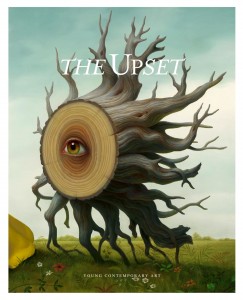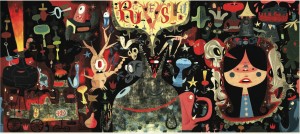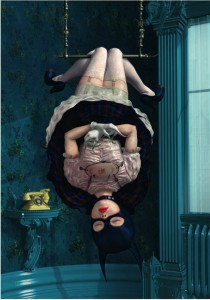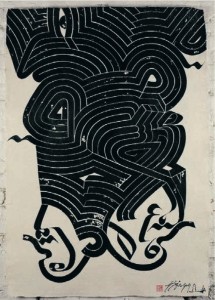The Upset: Hilo for Your Coffee Table
By:
April 3, 2009
 Much contemporary art prides itself on posing questions. But too often the questions are rehearsed, and the answers prompt only tepid flickers of sensation. Works that engage the imagination in a total fashion — that acknowledge obsession, desire, and mortal terror — more often may be found in religion, in pornography, in schlock, and in sports spectacles of the most violent and glamorously degrading sort. Or so goes the middlebrow party line.
Much contemporary art prides itself on posing questions. But too often the questions are rehearsed, and the answers prompt only tepid flickers of sensation. Works that engage the imagination in a total fashion — that acknowledge obsession, desire, and mortal terror — more often may be found in religion, in pornography, in schlock, and in sports spectacles of the most violent and glamorously degrading sort. Or so goes the middlebrow party line.
But there are artists working at a high pitch of sophistication and technique who also make a total commitment to imagination. They’re stalked by various labels: lowbrow, street, goth, underground. Many learned their lessons in color and form by doing graffiti, design, and illustration, by working in skate shops, tattoo parlors, or other worlds removed from the gallery and museum context of mainstream art. The work of many of these artists is gathered in the book The Upset, a ravishing omnibus published by Gestalten.
In a couple of senses, the subtitle of The Upset—”Young Contemporary Art”— is a misnomer. Many of these artists have been working for years; some, like John Currin, have enjoyed a tenure as gallery darlings. At a deeper level, however, much of the work here seems primordial, as old as making.
Southern California artist Tim Biskup works in acrylics, spray paint, and gold leaf applied to wooden panels. His paintings evoke cartoons, folk art, and the febrile visions of Hieronymus Bosch.

Ray Caesar’s uncanny paintings spring from a world of “etiquette, craft, and meticulous care,” the manners of a wallflower who “is really the queen of the entire evening.” In his work, the ornament and excess of Watteau meets classic cars and superhero longings.

Korean-born artist Rostarr works in many media; his paintings in The Upset evoke graffiti, architecture, and calligraphies of Asia and the Near East.

Like others featured in The Upset, these are post-countercultural artists; they know that the mainstream long ago co-opted the revolutionary energies of the twentieth-century’s avant-gardes. Aware of their marginality, they’re sincere, obsessed believers. Their art doesn’t negate or cancel out the high and the low; it doesn’t reach for the petty catharsis of submerged tendencies. It thrives instead in the flux, the arc of energy that springs up where engagement and irony meet. That’s what makes The Upset a hilobrow coffee table treat.
